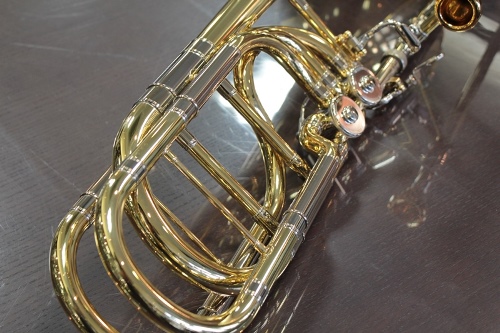I would challenge the assertion that you prefer gold bells more than yellow bells, for starters. There are so many variables in the whole situation that just the premise that you want to switch - barring you trying something actually identical but with a gold bell (and assuming they are in the same condition) that you are comparing apples to oranges. You might like
a horn that happens to have a gold bell but there are many parts of the horn between your lips and the sound that comes out of the bell.
You didn't mention the model of the horn (and your picture seems to not have sufficient privileges to share outside your account perhaps?) But know that not all horns have otherwise identical specs between different bells. For example, the Bach 42 and 42G you would think would be the same weight --- but usually the gold bell is a heavier gauge than the yellow brass bell. I've done similar conversions to several horns and you more-or-less have to want to tinker and experiment as much as you want a functional horn. In my experience, most of the time you'd be better off financially by just finding a horn that you want in the long run and being patient. But I'm not good at being patient and I like tinkering so I make odd horns!
What gold brass bell are you thinking of putting on? That's also important. Some take more work than others to put on and obviously you'll have a different experience putting on another brand's bell on your horn. This isn't an attempt to dissuade you from trying to do this, that would be a severe case of pot calling the proverbial kettle black. Just potentially that information would be very useful because there might be pitfalls or thigns to look out for depending on the context that you are trying.
So to actually sort-of answer your questions:
1) Edge bracing can be great in my experience primarily because its just done well. It might be more difficult than you think depending on the way your horn is wrapped but once we know what model it is that'll make it easier to determine. I don't, frankly, put much into the way that a horn is braced so long as it isn't ridiculous. Its much more important that it be done well. So if your tech converts it to edge bracing and they do good work, it'll probably play better. If they don't, then it probably won't. I have a tremendous closed wrap, dependent tenor section that was build from a 36 section and some 88 parts. Its
heavily braced but I ended up keeping it over another open wrap + edge bracing valve section that I had at the time. It was just built with extreme care.
2) In my experience? Nothing. Maybe if you are extraordinarily tuned in to how your specific instrument plays. Again, this is assuming that it is assembled well. That isn't necessarily a good assumption. The contemporary way of making the horn modular that involves threaded bell nuts is extremely sturdy but you are talking about really, really light parts otherwise. If you were to be blind folded and pick up a Bach 42BO and a Bach 42BO that was converted to be modular, you wouldn't be able to tell the difference between them weight wise. Guaranteed. Heck, with as much variation as you are inclined to find between them, you might not even notice a difference with them on a scale if you weren't measuring for very small variances.
Note that on the forum in the Shires Q&A thread Ben Griffin indicated that some very attuned players were capable of detecting a difference --- I can't recall the specifics but I believe that portion of it did get copied over into the archives. But the effect was much less severe as you progressed into bass sizes. But the altos and small bores are fixed state because they were more noticeable and there were such a negligible number of players who needed those to be modular anyway.
3) Sort of touched on this but this is going to vary quite a bit depending on:
a) What your source horn is
b) How patient you are with used or if you want to go new
c) How willing you are to use other brand parts
d) How much your tech charges
It will most likely be cheaper than a new horn. On the extreme low end, you might get a used bell + matching hardware for $400-$600. On the high end, ~$1600. Then your'e looking at $300-$600 to have it all mounted depending on what exactly needs to be done. Possibly more if the wrap needs to be reworked. All in, it
could approach the price of a new bass, certainly a bell section. I don't know what labor costs are where you are so that would make a tremendous difference, as would import costs if you needed import. But that would - to some extent - also apply to the new bell.
If you indicate the horn people might have done similar things and may be able to better help.
PS. Someone asked a very similar question in a PM o m a few week ago and I totally dropped the ball. I'll make a note of that and try to respond this week. October is to medical research like tax season is to an accountant


